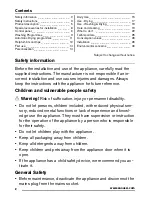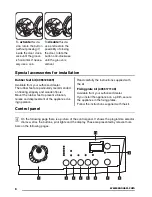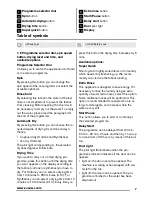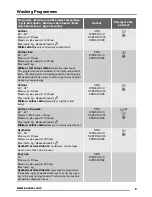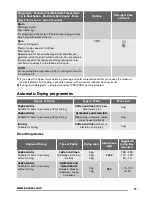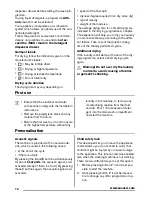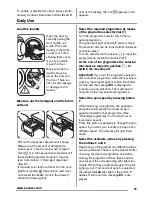
Degree of Drying
Type of Fabric
Drying Load
Spin Speed
(rpm)
Suggested
drying time
(minutes)
Iron dry
Suitable for ironing
Cotton and linen
(sheets, tablecloths,
shirts, etc.)
6 kg
4 kg
2 kg
1400
150 - 170
90 - 100
50 - 60
Hints for test institute
Test performance, in accordance with EN 50229, must be carried out with the a first drying load of 5 kg
(load composition : pillowcase and towels) by selecting the TIMED DRYING programme for Cotton and set-
ting 120 minutes.
The second drying load of 3 kg (load composition : 3 sheets and towels) must be tested by selecting the
TIMED DRYING programme for Cotton and setting 85 minutes.
Helpful hints and tips
Sorting out the laundry
Follow the wash code symbols on each gar-
ment label and the manufacturer’s washing in-
structions. Sort the laundry as follows: whites,
coloureds, synthetics, delicates, woollens.
Before loading the laundry
Never wash whites and coloureds together.
Whites may lose their «whiteness» in the wash.
New coloured items may run in the first wash;
they should therefore be washed separately the
first time.
Button up pillowcases, close zip fasteners,
hooks and poppers. Tie any belts or long tapes.
Remove persistent stains before washing.
Rub particularly soiled areas with a special de-
tergent or detergent paste.
Treat curtains with special care. Remove hooks
or tie them up in a bag or net.
Removing stains
Stubborn stains may not be removed by just
water and detergent. It is therefore advisable to
treat them prior to washing.
Blood:
treat fresh stains with cold water. For
dried stains, soak overnight in water with a spe-
cial detergent then rub in the soap and water.
Oil based paint:
moisten with benzine stain
remover, lay the garment on a soft cloth and
dab the stain; treat several times.
Dried grease stains:
moisten with turpentine,
lay the garment on a soft surface and dab the
stain with the fingertips and a cotton cloth.
Rust:
oxalic acid dissolved in hot water or a
rust removing product used cold. Be careful
with rust stains which are not recent since the
cellulose structure will already have been dam-
aged and the fabric tends to hole.
Mould stains:
treat with bleach, rinse well
(whites and fast coloureds only).
Grass:
soap lightly and treat with bleach
(whites and fast coloureds only).
Ball point pen and glue:
moisten with ace-
tone
1)
, lay the garment on a soft cloth and dab
the stain.
Lipstick:
moisten with acetone as above, then
treat stains with methylated spirits. Treat any re-
sidual marks with bleach.
Red wine:
soak in water and detergent, rinse
and treat with acetic or citric acid, then rinse.
Treat any residual marks with bleach.
Ink:
depending on the type of ink, moisten the
fabric first with acetone
1)
, then with acetic acid;
treat any residual marks on white fabrics with
bleach and then rinse thoroughly.
Tar stains:
first treat with stain remover, me-
thylated spirits or benzine, then rub with deter-
gent paste.
Detergents and additives
Good washing results also depend on the
choice of detergent and use of the correct
quantities to avoid waste and protect the envi-
ronment.
1)
do not use acetone on artificial silk
12
www.zanussi.com
Содержание ZKN7147J
Страница 1: ...EN User manual Washer Dryer ZKN 7147 J ...
Страница 32: ...www zanussi com shop 132935113 A 502012 ...


